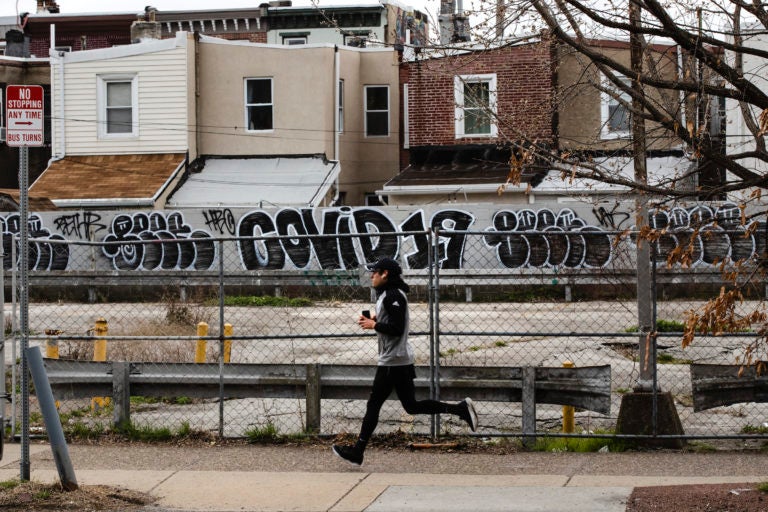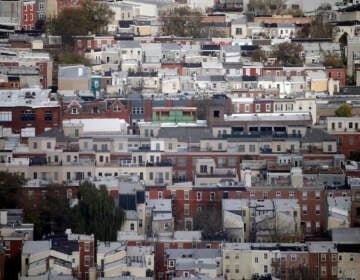Amid COVID crisis, Trump moves to quietly gut laws against racist lending
The Trump administration is poised to weaken a civil rights-era law meant to guard against discriminatory lending.

A jogger runs past a wall painted with the word "COVID 19" in Philadelphia, Wednesday, March 25, 2020. (AP Photo/Matt Rourke)
The federal government is poised to weaken a law that desperately needs to be strengthened—and to do so in the midst of the COVID-19 crisis, depriving people of the chance to weigh in.
Before we knew that the coronavirus had spread to the United States, federal agencies had proposed changes to the Community Reinvestment Act (CRA), a civil rights-era law meant to reduce discrimination in lending. The agencies opened a public comment period — an essential step in the regulatory process that allows people affected by a proposed rule change to be heard and to advocate for improvements. Since then, our world has been upended. People, businesses, and governments are evolving and adapting as businesses, schools and communities close or operate remotely so people can stay home and stop the virus’ spread.
Yet the federal agencies have so far refused to extend the public comment period by a single day—despite requests from advocates around the country. Still, it is not too late for Philadelphians to fight to preserve and strengthen this law, which will be as important as ever when life returns to a new normal.
The proposed changes would undo banking regulations put in place to ensure that all of the city’s communities get equal access to investment and loans — laws designed to protect businesses and residents of areas that have already been hit hard by coronavirus
To understand what is at stake, it helps to recall that 50 years ago, lenders refused to loan money to people of color. This discrimination was legal at the time, and in fact, relied on maps, guidelines, and practices created by the federal government. The maps used red lines and barely-coded racist language to indicate where loans should not be made—areas with “detrimental influences” and an “undesirable population or an infiltration of it.” The effects of redlining are still palpable across Philadelphia and in communities color around the country today.
Redlining is an important part of our history, but is it not just history. There is no doubt that access to credit and banking in communities of color remains limited today. But things could be worse, and that’s thanks in part to changes in federal law. Today it is illegal to discriminate in lending. The Fair Housing Act and Equal Credit Opportunity Act, passed in the late ‘60s and early ‘70s, outlawed discrimination in home loans and consumer lending on the basis of race or its proxies, like neighborhood. And in 1977, Congress went one step further. It passed the CRA, which imposed an affirmative duty on banks to lend in the communities where they accept deposits. The idea was simple: When banks accept money from people in a given neighborhood, they should also lend money to people and businesses there. The law requires banks to invest in all communities they serve, including low- and moderate-income (LMI) neighborhoods, consistent with “safe and sound” lending practices.
That was the idea, at least. And it has done some good. In theory, the law gives banks a reason to make loans in the LMI areas they serve—loans they might otherwise make in wealthier areas.
From 2009 through 2018, for example, banks in our area reported making $45 billion in mortgage loans and $8.7 billion in business loans in lower-income neighborhoods. It is difficult to isolate the impact of the CRA, but we know that much of this lending may be at risk with the proposed regulatory roll back. Researchers found in 2017 that, when census tracts in Philadelphia lost their CRA eligibility, lending there decreased by 10- 29%.
Additionally, because banks’ CRA records are considered when banks seek to merge, the law can give the affected community a seat at the table. In 1986, when two Philadelphia banks proposed a merger, 34 community groups banded together to challenge it. The broad coalition, represented by Community Legal Services, charged that the banks had violated the CRA by refusing to make loans in the low-income, mostly minority neighborhoods of Kensington and North Philadelphia.
The coalition won real benefits for the community; the banks agreed to make low-interest home purchase and improvement loans to residents and to fund housing and economic development projects. And later, after sub-prime lenders peddled high-cost predatory loans to low-income, minority residents and the country headed toward the foreclosure crisis, these low-interest CRA loans continued to perform well.
Eviscerating an ‘antidote to redlining’
But as is plain to anyone walking the streets of our city today, the CRA has not reversed the damage done by decades of discrimination and disinvestment in communities of color. Banks continue to loan money more freely to white people than to people who are Black, Hispanic, Asian, or Native American.
Given the challenges before us, the CRA needs to be strengthened and modernized now. Instead, the federal agencies charged with administering the law have proposed rule changes that would water it down even more, rendering it toothless.
For example, banks could get credit under the CRA when they loan money to businesses with annual revenue of $2 million, even though 95% of small businesses make less than $1 million per year. Banks would be able to get credit for providing financial education to people of any income level, rather than the lower income people the law is intended to serve. Banks could get credit for “mixed-income” housing when they invest in middle-income rental units in high-cost area, even where there is no benefit whatsoever to low-income people. They could even get credit for building sports stadiums in certain neighborhoods. Put simply, the proposed changes would gut the CRA.
The CRA was envisioned as the antidote to redlining—an antidote we still desperately need. Today our city remains segregated and it is still difficult for people of color to get a fair loan to buy a home or make necessary repairs.
According to data analysis done by Reveal at the Center for Investigative Reporting, an African American in Philadelphia is 2.7 times more likely to be denied a conventional mortgage than a white person with the same income, seeking the same size loan in the same neighborhood. And despite similarly sized populations in the city, white Philadelphians received ten times as many conventional loans as Black Philadelphians.
Reveal found similar inequity in lending across the country. Despite these disturbing trends, regulators have found that 98% of banks are complying with the CRA. One piece of this confounding puzzle is that any loan a bank makes in a CRA-qualifying geographic area can be counted under the law—even when that loan is made to a middle-income white person seeking to buy a home in a gentrifying area, rather than a longtime resident of color. And in Philadelphia, that’s exactly what banks are doing, Reveal found.
And if the proposed changes go through unchecked, this inequity will only be compounded as Philadelphians seeks to rebuild after the COVID-induced economic crisis.
The CRA cannot undo centuries of institutional racism, but principled improvements to the law could reinvigorate it as a valuable tool.
The public has a right to comment on the proposed CRA changes. For more information about the proposed changes or to submit a comment online before the April 8, 2020, deadline, visit https://www.regulations.gov/comment?D=OCC-2018-0008-1960.
Laura Smith is an Independence Foundation Fellow and an attorney at Community Legal Services of Philadelphia. She can be reached at lsmith@clsphila.org.
WHYY is your source for fact-based, in-depth journalism and information. As a nonprofit organization, we rely on financial support from readers like you. Please give today.







![CoronavirusPandemic_1024x512[1]](https://whyy.org/wp-content/uploads/2020/03/CoronavirusPandemic_1024x5121-300x150.jpg)


